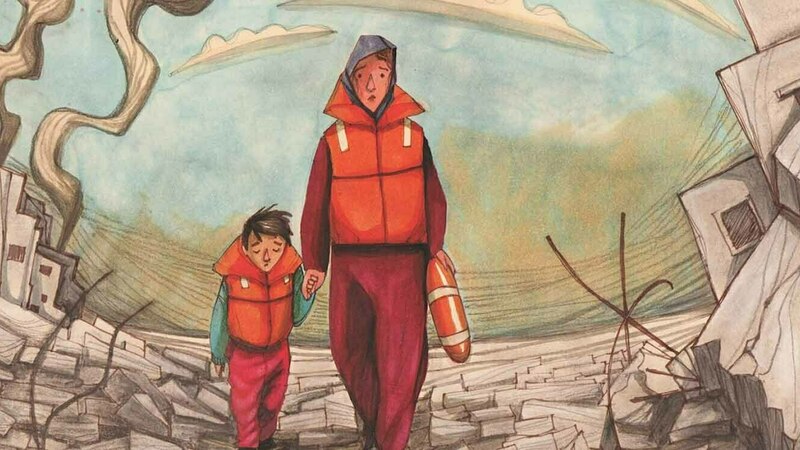
Life Jacket
Diala Brisly
Not just those in the sea ...
By: Anna Gazewood '24
In the last twenty years, the global refugee crisis has become a pressing issue on the European continent. According to the 1951 Refugee Convention, a refugee is someone who, “owing to a well-founded fear of being persecuted for reasons of… membership of a particular social group,” is unable to reside in their country of nationality or avail themselves of that country’s protection. The United Nations High Commission on Refugees (UNHCR) has expanded this definition to include those unable to return to their home country due to “armed conflict, violence, or serious public disorder.”
To a large degree, the current patterns of armed conflict and political instability in Europe are attributable to the legacies of colonialism. In his book on the Syrian refugee crisis, sociologist Danilo Mandíc dismantles the innocence complex of developed countries by showing how their actions have exacerbated the refugee crisis. In particular, the militarization of the Mediterranean and constantly changing border restrictions in the European Union have made the migratory journey much more risky. Even after enduring life-altering traumas in war-torn regions or during the process of migration, refugees face discrimination and social stigmatization when they reach their destination. Amid these obstacles, refugee artists, such as Diala Brisly, use their art to humanize refugees and victims of war and illustrate the complexity of their experiences. Brisly began her career as a cartoonist in Syria in the early 2000s, and her work utilizes media from animation to painting and illustration. As a result of the Syrian civil war, she fled in 2013 and is now based primarily in France. Brisly’s illustrations are often for children impacted by war and displacement. For example, she painted murals for refugee schools in Lebanon to inspire children to return to school whose education and lives had been uprooted. In Lebanon, she also hosted workshops for children to teach them how to express their emotions through art. Brisly’s cartoons portray messages of hope amidst tragedy, particularly for women and children.
Brisly’s "Life Jacket series" portrays the ramifications of war for those it displaces. She employs a whimsical style of drawing in this collection that is similar to a children’s book. At the same time, these cartoons deal explicitly with the horrors of war. A central symbol throughout her illustrations is a life jacket, which calls to mind the unseen burdens that many refugees carry and the hope of a better future after the journey.
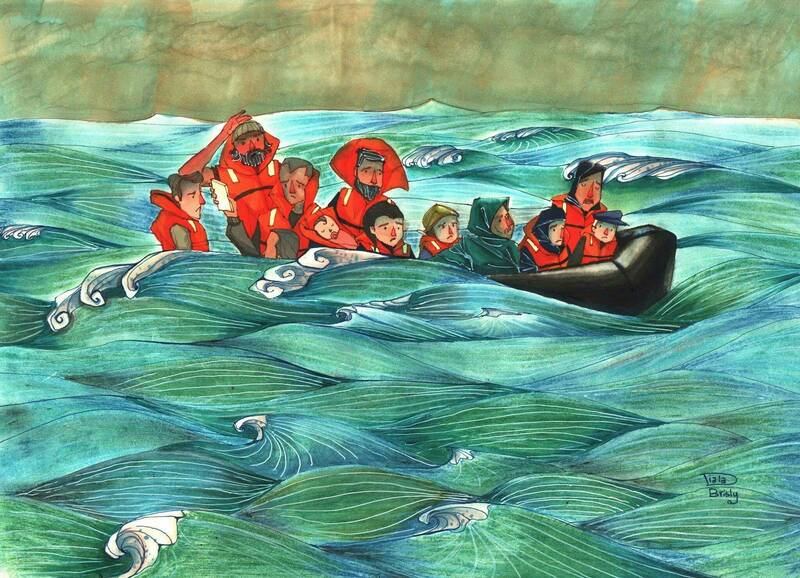
"It's a baby girl" by Diala Brisly, from the Life Jacket series, illustration, 2016. Used with permission.
The illustration “It’s a Baby Girl” from the Life Jacket series depicts the image of a raft bringing refugees across the Mediterranean to Europe. Whereas Western media outlets often portray these boats as sensationalized images of suffering, Brisly offers a more nuanced approach. Although the forlorn expressions of the people on the boat point to the gravity of their situation, the presence of the newborn suggests an undercurrent of hope. Like the adults in the image, the child is wearing a lifejacket, signaling that she was born into this experience of risk and uncertainty. Still, the illustration shows how life perseveres even in these challenging circumstances. “It’s a Baby Girl” forces the viewer to reckon with the unfathomable reality that some children begin their life on a boat, uncertain of where–or even if–they will make it to shore and whether they will be turned away once they arrive. Yet, the birth of the child represents hope for the future and a better life.
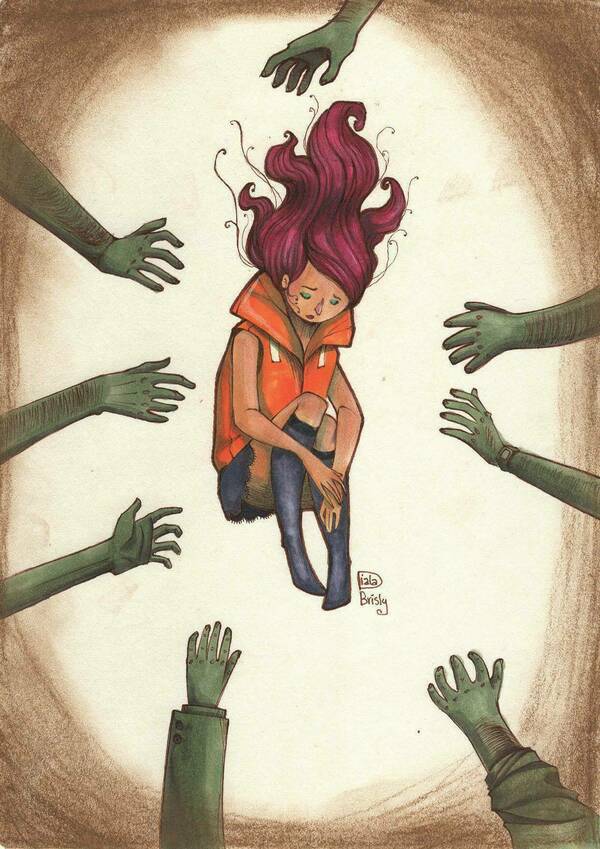
“Get me out of here,” another piece in Brisly’s Life Jacket series, portrays a refugee woman who is a victim of sex trafficking. In this stark image, a young woman lies in a fetal position with a downcast expression as ghostly, almost demonic hands reach for her. Brisly plays with perspective, as it is unclear if the viewer is looking down at the woman or whether she is falling through space. The woman is the focus of the illustration, yet she is not in control of her situation. This piece highlights the prevalence of gender-based violence in the refugee experience, which is often ignored by mainstream media.
In “Get Me Out of Here,” Brisly implores the audience to empathize with the woman’s emotions even if they cannot relate to her experience. Women refugees face unique forms of violence throughout the process of migration. Many were forced to leave their homes due to a lack of safety and fear of violence in their home country. During the journey, they experience forms of gender-based violence from multiple sources, including smugglers, local police, and even other refugees. Because refugees have no state protection, they are especially vulnerable and lack channels through which to report these abuses.
As a refugee herself, Brisly brings a lens of authenticity and reverence to her work that is often not present in other representations of refugees. Against the backdrop of sensationalized and dehumanized pictures of suffering, Brisly offers a personal perspective on the experiences of refugees. According to Brisly, art offers a better solution–a way of understanding war without looking at death and violence. In an interview with the International Rescue Committee, Brisly remarked that the people that she draws are personal to her; she feels like she knows them. Thus, Brisly’s illustrations humanize refugees and highlight their courage to keep going. By immersing the audience in understandable narratives and relatable emotions, Brisly showcases the danger war poses to humanity. The lifejacket serves as a dual symbol of the inherent dangers and hope associated with the refugee experience. In discussing the meaning of the life jacket in her work, Brisly notes that everyone needs a life jacket, “not just those in the sea.”

Anna Gazewood is a senior at the University of Notre Dame studying political science and music with a minor in public service. This past winter, she worked on the Nanovic project entitled "Ukrainian Art as Protest and Resilience," for which she researched and wrote about patriotic tattoos. This coming academic year, she is serving as the president of the Notre Dame Chorale and writing her senior thesis in political science. She is originally from Charlottesville, Virginia.
Research by: Anna Gazewood
Art by: Diala Brisly
Theme: Migration
Header art: "Life Jacket" by Diala Brisly, from the Life Jacket series, illustration, 2016. Used with permission.
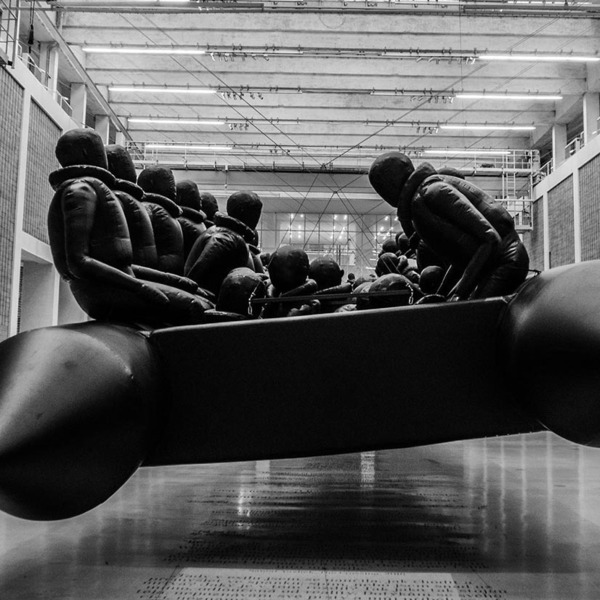
Law of the Journey & Europe’s Forgotten Graveyard
Art by Ai Weiwei, documentary by Jean-Marc Joseph, research by Monay Licata
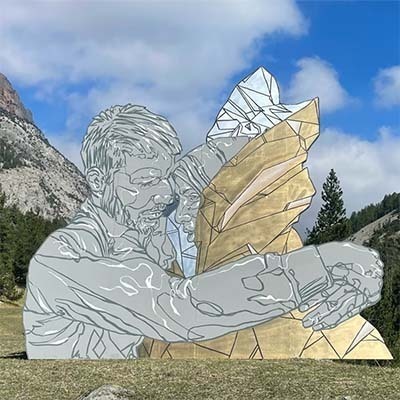
Fragments de Voyages
Art by Mahn Kloix, research by Ethan Chiang